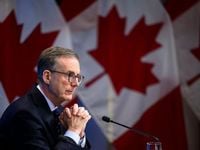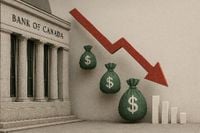The Bank of Canada is on the verge of making a pivotal decision regarding interest rates as it prepares for its third rate announcement of 2025 on Wednesday, April 16. Amid global economic uncertainties and fluctuating trade policies, the central bank is expected to maintain its overnight rate at 2.75%.
Recent polling by Reuters indicates that just over 60% of economists anticipate the Bank will hold its current rate steady, while 11 out of 29 economists foresee a potential cut of 25 basis points. This cautious approach comes as markets have shifted their expectations, with the likelihood of a rate cut now pegged at approximately 32%, down from 40% following President Trump’s recent tariff pullbacks.
Marc Ercolao, an economist at Toronto Dominion Bank, expressed that "the door is certainly open for the bank to trim the policy rate by another 25 bps as a precautionary measure." However, he also noted that a pause remains a viable option. The Bank of Canada had previously cut rates in March due to the looming threat of tariffs from the U.S., but the situation has since evolved, with Canada successfully avoiding further reciprocal tariffs on April 2.
Despite this reprieve, the Canadian economy faces significant challenges. Economists now predict a modest growth of just 1.2% for 2025, a stark reduction from earlier forecasts. Prime Minister Mark Carney has voiced concerns, stating, "There are initial signs of slowing in the global economy," and highlighted the adverse effects of the tariff war on both Canadian markets and employment.
The consensus among economists is that inflation is expected to rise, with projections for March's Consumer Price Index (CPI) reading at 2.6%, unchanged from February. Douglas Porter, chief economist at BMO Capital Markets, suggested it could reach 2.7%, potentially pushing Canada’s inflation rate above that of the United States for the first time in five years.
With inflation on the rise, the Bank of Canada is faced with the delicate task of balancing economic growth against inflationary pressures. There is a growing sentiment that further rate cuts may be necessary, even if the Bank decides to hold steady this week. More than half of the economists surveyed by Reuters predict two additional cuts by the end of the third quarter, potentially lowering the rate to 2.25% or even 2% as suggested by Capital Economics and BMO.
The impact of the ongoing trade war is evident in consumer sentiment, which has taken a hit. The University of Michigan Consumer Sentiment Index for April has dropped to its second-lowest level since 1978, with many respondents fearing rising unemployment in the coming year. Jocelyn Paquet, an economist with National Bank of Canada, noted, "The median consumer sees prices rising 6.7% over the next 12 months, the most since October 1981," which is likely to grab the attention of policymakers.
The Bank of Canada’s decision will be closely watched by investors and analysts alike, as interest rates hang in the balance. The central bank's approach to this decision reflects the broader global dynamics that influence national economic policies. The interplay of trade tensions and domestic economic indicators will shape the Bank's strategy moving forward.
As the Bank of Canada prepares for this crucial announcement, it remains to be seen how it will navigate the conflicting pressures of inflation and economic growth. The uncertainty surrounding trade policies and their implications for the Canadian economy adds another layer of complexity to its decision-making process.
In summary, the upcoming rate decision comes at a time when the Canadian economy is grappling with significant challenges. The Bank of Canada must weigh the potential benefits of further rate cuts against the risks of rising inflation and a slowing economy. As the situation unfolds, market participants will be keenly observing the Bank's next moves, which could have lasting implications for the Canadian economy.









